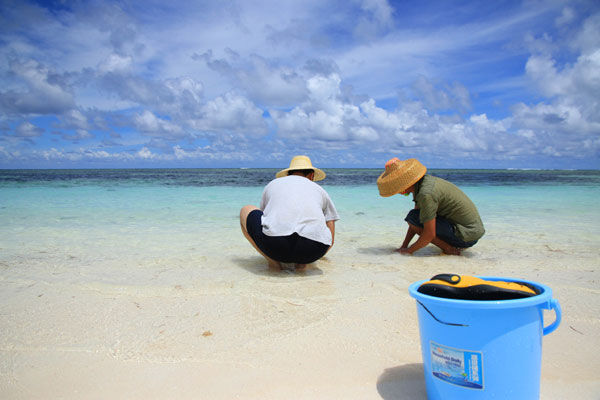Upgrade to boost island chains
Updated: 2012-07-02 01:48
By Hu Yongqi, Wu Wencong in Beijing and Huang Yiming in Haikou (China Daily)
|
||||||||
Sansha city will become a major administrative center in the South China Sea. Hu Yongqi and Wu Wencong report from Beijing and Huang Yiming from Haikou.
 |
|
Yongxing Island, part of the Xisha Islands, has government buildings and banks. Meng Fulin/for China Daily |
No one was more pleased with the establishment of Sansha city than Deng Dazhi of Qionghai city, Hainan province. After 30 years of voyaging around the South China Sea, he knows just how much fishermen rely on the support of the local authority.
Deng, 49, has fished around most of the islands in the area. Each trip lasts more than a month, but to be on the safe side, Deng ensures he carries enough food and water to last at least eight weeks. "There is no clean drinking water on most of the islands, and we can't even find a place to sleep. The only way to survive is to take water, food and tents everywhere we go," Deng said.
Yongxing Island, part of the Xisha Islands, has long been a favored destination for Deng and his crew because government agencies have been running the island for 50 years.
Soldiers constructed two harbors on the island, one for civilian use, which meant that the fishermen could anchor there and visit the local supermarket for essential supplies. "The only place we really feel secure is Yongxing Island, because we know food, water and help can be found there," Deng said.
He said he had often wished that more administrative centers could be established on other isolated islands. Now that wish seems to be becoming a reality.
The State Council upgraded the administrative status of Xisha, Nansha and Zhongsha islands to prefecture level from county level last month, a move designed to improve interisland administration.
That will see Sansha replace the county-level administration office on Yongxing Island as the center for the Xisha, Nansha and Zhongsha islands. It will administer the three island groups and surrounding waters. In total, the city government will have jurisdiction over more than 200 islands, covering 130,000 square kilometers of land and 2 million sq km of ocean.
"The setting up of a new city means a lot to me and my fellow mariners. That will be helpful when emergencies at sea arise. So I am really looking forward to the change," said Deng.
The upgrading of the city's status was also designed to improve the life of lots of fishermen, islanders and scientific researchers. For them, the upgraded institution will provide an improved infrastructure and additional support from central government.
Resource development
"The establishment of Sansha city is huge blessing for the conservation and development of fishery resources and for scientific research into marine fisheries," said Li Xiangmin, director of Hainan Provincial Fisheries Research Institute.
Li made his first trip to the three island groups in May 1986, when he was deputy director of Qionghai county bureau of fisheries. The hard life the fishermen endured left a deep impression on him.
"The voyages were very long, usually with atrocious weather posing a very high risk to life," he said. "When they were out there on the sea, they could only eat fish and salted vegetables and had no chance of getting fresh vegetables or fruit."
Li said local records showed that Qionghai residents have been fishing the waters around Sansha since 1681, often using the traditional diving method. "With no equipment, the method they used was primitive: Taking a long, deep breath," said Li. He said many fishermen drowned or died from decompression sickness, commonly known as the bends, when they came up to the surface. The situation didn't improve until the introduction of bottled oxygen in the 1990s.
"Nowadays, fishing boats are equipped with positioning devices, walkie-talkies and satellite phones. These things help ensure the fishermen's safety," said Deng.
The Hainan Provincial Fisheries Research Institute started scientific research into fishery resources in the South China Sea in 2008. "The reserves of pelagic fish, those that live close to the surface, are very rich in the South China Sea, but they weren't really developed in the past because of the long voyages involved and poor backup," said Li. "It will be possible to expand the regional fishing industry when the central government provides more research programs and favorable policies."
Li said tropical fishing, the marine products industry and tourism will all benefit from the decision to establish Sansha city.

 Relief reaches isolated village
Relief reaches isolated village
 Rainfall poses new threats to quake-hit region
Rainfall poses new threats to quake-hit region
 Funerals begin for Boston bombing victims
Funerals begin for Boston bombing victims
 Quake takeaway from China's Air Force
Quake takeaway from China's Air Force
 Obama celebrates young inventors at science fair
Obama celebrates young inventors at science fair
 Earth Day marked around the world
Earth Day marked around the world
 Volunteer team helping students find sense of normalcy
Volunteer team helping students find sense of normalcy
 Ethnic groups quick to join rescue efforts
Ethnic groups quick to join rescue efforts
Most Viewed
Editor's Picks

|

|

|

|

|

|
Today's Top News
Health new priority for quake zone
Xi meets US top military officer
Japan's boats driven out of Diaoyu
China mulls online shopping legislation
Bird flu death toll rises to 22
Putin appoints new ambassador to China
Japanese ships blocked from Diaoyu Islands
Inspired by Guan, more Chinese pick up golf
US Weekly

|

|






